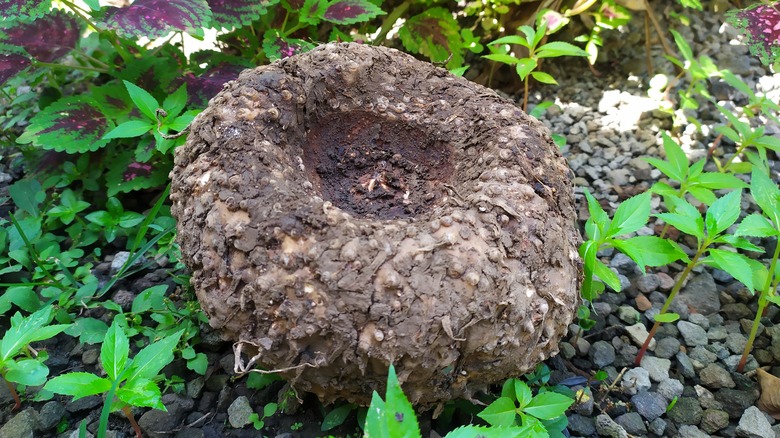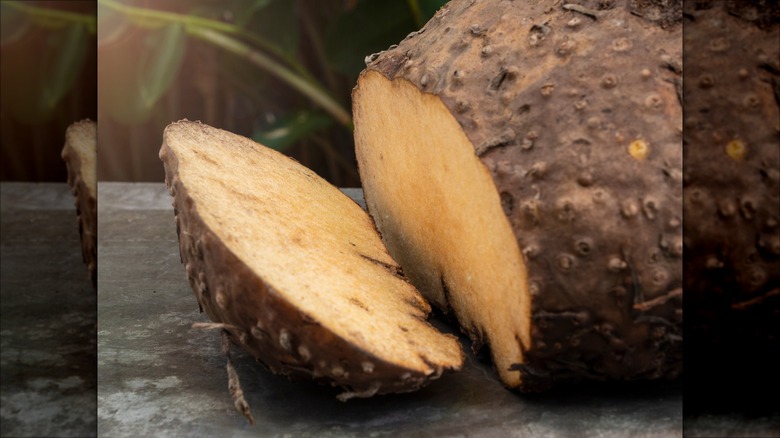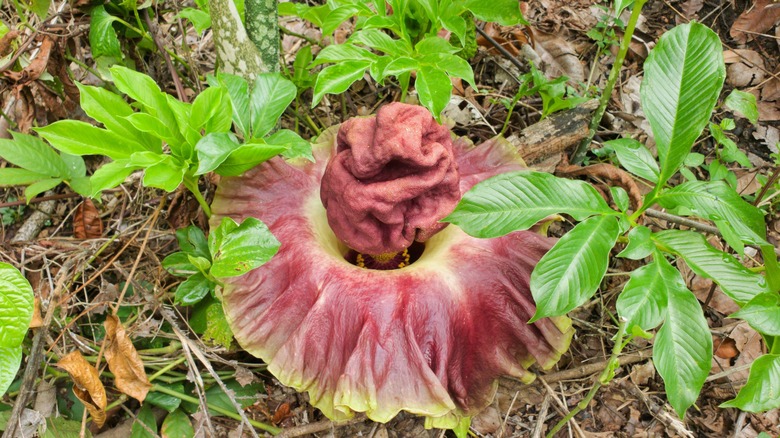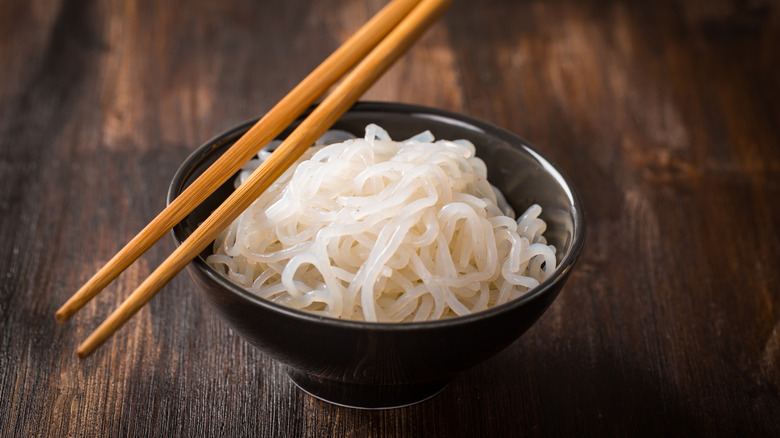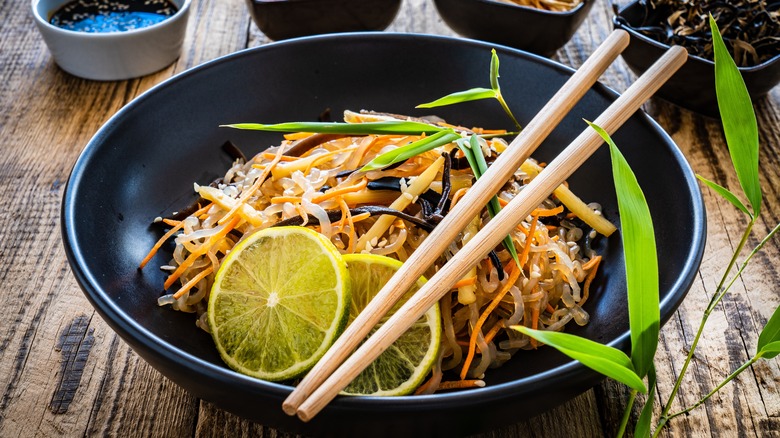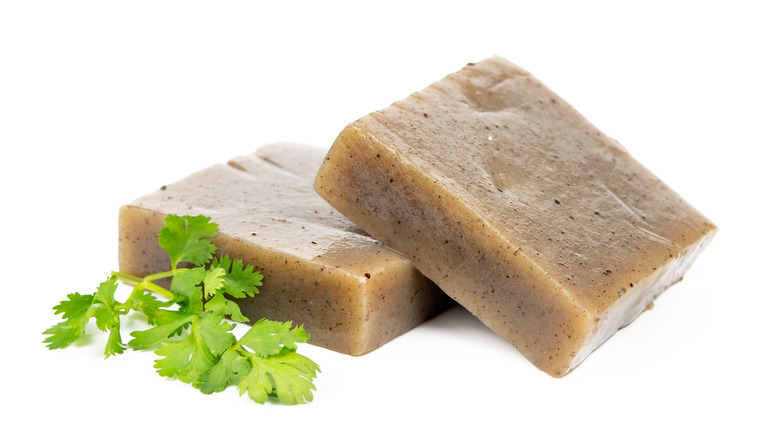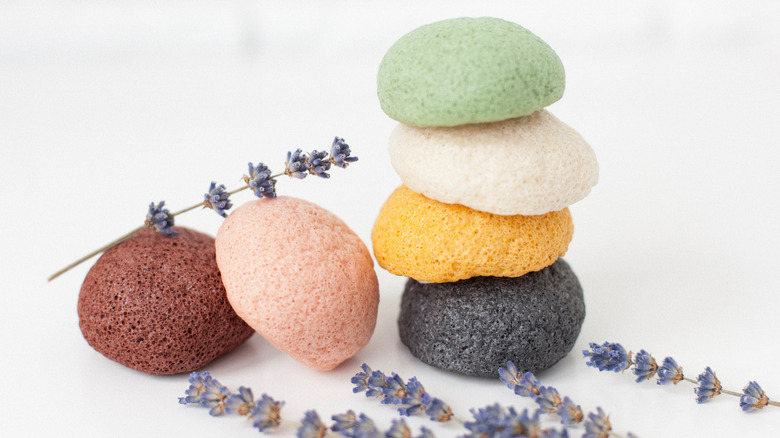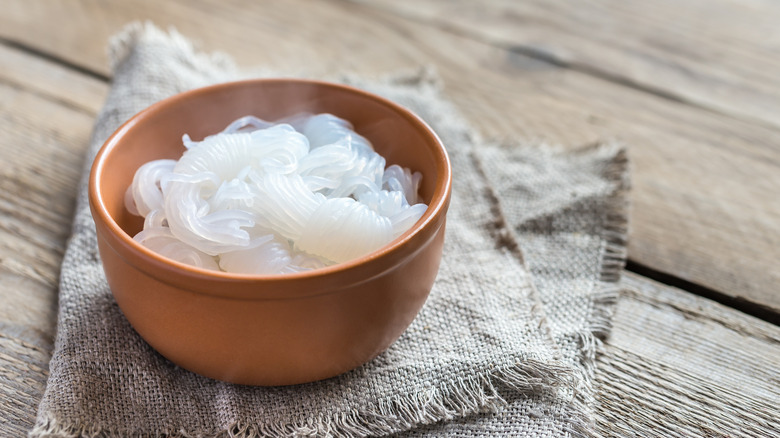What Is Konjac And What Does It Taste Like?
Reading food labels sometimes feels like a task requiring a doctorate in chemistry. The crazy list of ingredients on food products seems endless, and many of them are multisyllabic franken chemicals that are added to either increase shelf-life or improve the texture of a product. We recently stumbled upon one such foreign ingredient with a simple enough name that we didn't recognize: konjac.
As per usual, we headed straight for the internet to find out what this bizarre ingredient was. It turns out that it is not so weird at all. It is a root vegetable that has been a staple in Japanese and Chinese culinary and medicinal traditions for hundreds of years.
In the Western World, Konjac has been recognized as having an abundant amount of a specific kind of soluble dietary fiber called glucomannan, according to Healthline. This fiber can be converted into nutritional supplements or used as a texture enhancer for numerous processed foods, like gluten-free pasta. We wanted to know more about this curious tuber and how it can play an integral role in health and culinary contexts. Let's look closer at the origins and evolution of the Konjac.
What is Konjac?
Konjac, or Amorphophallus konjac, is a perennial plant that grows in tropical and subtropical regions throughout Southeast Asia, predominantly Japan, China, and Indonesia. The plant, also known as voodoo lily, konjaku, elephant yam, devil's tongue, snake palm, leopard arum, and umbrella arum, is a member of the philodendron family, which is often cultivated in the U.S. for its distinct foliage. It is most commonly known for its corm, the root-like tuber that grows underground and can reach up to 50 pounds and 12 inches in diameter.
These plants were originally brought to Japan between 500 and 800 years ago, where they were a culinary commodity reserved for the wealthy elite. They initially found their way to China via Buddhist monks, who revered them for their purported medicinal value.
The plants grow best in warmer climates and at altitudes between 2,400 to 4,500 feet. Though the corm of this plant is hardy, its foliage is quite delicate, requiring adequate moisture and sun to thrive. Konjac can grow to 4 to 6 feet tall, with leaves that are proportional to the diameter of the corm. The Konjac corm is unusually high in fiber and low in starch, distinguishing it from other root vegetables.
What does Konjac look like?
The morphology of the Konjac plant is very unique. A single mauve-colored stem-like petiole with moss-hued spots emerges from the tuber. This yields a single leaf, which splits into three segments with leaf blades adorned by verdant leaflets, creating a parasol-like shape. In larger plants, these can have the appearance of a small tree.
Once a year, between late winter and early spring, a single purplish-red flower blooms from the petiole. This blossom, which resembles a large Alcatraz flower, is considered a monoecious plant, meaning it has both male and female reproductive organs. The female pistils are at the bottom of the flower, while the male stamen protrudes from the top. When in bloom, this flower has the aroma of rotting flesh, presumably an adaptation to help attract pollinating creatures.
The edible tuber looks like a cross between a yucca, a sprouting potato, the hull of a coconut, and a shiitake mushroom, on the exterior. Its flesh is cream-colored with a texture that looks like part potato and ginger root but is quite gelatinous and gummy due to its porous and starchy nature. This porosity is what has made it a popular material to use for making skin-smoothing sponges.
What does Konjac taste like?
The question of what Konjac tastes like is both ironic and interesting. Most resources suggest that when eaten prepared alone, it doesn't taste much like anything. While it has a slightly grassy and oceany aroma, this does not generally translate to the flavor when cooked. At most, it has a hint of salinity, but this is very mild, which makes it a blank slate.
Its gelatinous porous texture, combined with this neutrality, gives it the distinct capacity to absorb the flavors of whatever it is cooked alongside, making it a chameleon in the kitchen. And because it is a low-carb, gluten-free vegetable, it is uniquely suited to myriad dietary needs. It is a highly sought-after supplement for those on keto, paleo, or low-glycemic diets.
This neutrality is also the key to its use as a common food additive. Glucomannan, the water-soluble dietary fiber obtained from dehydrated Konjac, has tremendous viscidity, higher than most similar additives when used in identical quantities, including carrageenan, xanthan gum, and gum arabic. This means that when added to a food product, it can thicken and emulsify it without conferring additional flavor. Therefore you will often find it in gluten-free pasta, jams, jellies, salad dressings, and more.
How to cook with Konjac
The culinary uses of Konjac are virtually endless. To consume Konjac, the corm, or root end, is sliced, dehydrated, and then pulverized into flour. The flour is often utilized as a vegan substitute for gelatin in desserts, as a thickener in soups and sauces instead of a roux or cornstarch, and added to gluten-free baked goods to help provide a more pleasant elastic texture. When baked into bread, it is recommended that the ratio include less than 25% Konjac flour, or you may detect a slightly fishy flavor conferred by the compound trimethylamine.
The flour can also be turned into a noodle, known as Shirataki in Japanese, or a type of rice. These low-carb, gluten-free noodles are 97% water and only 3% starch. Their texture is somewhat gelatinous, and their odor is a bit seafood-forward. This can get mitigated by rinsing the noodles in cold water before cooking them briefly in boiling water with vinegar. The cooked noodles should be pan-fried in a dry pan for several minutes to remove any remaining gloopiness. Once prepared, these noodles will take on the flavor of anything you add them to, from Asian hot pots to Italian dishes to Indian curries.
Lastly, Konjac flour can be turned into a block known as a yam cake, broken up and used in recipes or turned into jelly. The jelly is a common ingredient in desserts, like lychee cups, sautéed with aromatics for a delicious side dish or converted into candy-like gummies.
Nutrition of Konjac
The potential nutritional benefits of incorporating Konjac into your diet are where this plant shines. Beyond its culinary uses for those requiring low-carb and gluten-free foods, the high levels of soluble fiber in the form of glucomannan may help lower cholesterol, regulate blood sugar levels, alleviate constipation, reduce the frequency of hemorrhoids, and prevent diverticulitis flare-ups, according to Healthline.
There are also suggestions that Konjac may aid in weight management by helping you feel fuller longer. And finally, Konjac has been linked with better dermal health by mitigating acne and encouraging faster healing of skin lesions. There are some potential contraindications to consuming Konjac or using supplements or gummies.
First, because of its impact on blood sugar levels, those with diabetes should be closely supervised by a medical professional while using Konjac. And like other fiber supplements, Konjac can cause gastrointestinal discomfort, including diarrhea, gas, bloating, and nausea.
But most significantly, because of the gelatinous qualities of Konjac, it can easily cause bowel obstructions and choking in susceptible populations, including those who are pregnant or breastfeeding, children, elderly individuals, or anyone with difficulty swallowing. For this reason, many countries have banned Konjac supplements.
Where to buy Konjac
If you are looking for Konjac flour, noodles, rice, jelly, gummies, or yam cake, you may have to turn to Asian grocers or ethnic markets to find these. Shirataki noodles can generally be found at most major grocery chains in the refrigerator section, along with tofu or in the Asian foods aisle. That said, you can find virtually any kind of Konjac food item online from numerous purveyors or have them delivered through Instacart or Amazon Fresh.
You can also find Konjac sponges of all different iterations online to incorporate into your daily skin regimen. While most of these are the same, there are some variations to be aware of, particularly for distinct skin conditions. Healthline suggests Konjac sponges laced with charcoal for those with oily skin or acne, those mixed with pink clay for anti-aging, and ones combined with red clay to promote hydration.
If supplements are more your speed, Healthline suggests you consult a physician before adding Konjac to your routine. Once you get the go-ahead, purchase a supplement from a reputable purveyor. For some helpful information on determining the safety and efficacy of a supplement, we recommend consulting the U.S. Food and Drug Administration Information for Consumers on Using Dietary Supplements guide, which is located on their website.
How to store Konjac
Depending upon the product you purchase, storage requirements will be unique. Flour can be stored in an airtight container in a cool, dry place, away from sunlight indefinitely. We recommend buying flour in smaller quantities and rotating your supply regularly for the best quality. Gummies and jelly should be stored according to the manufacturer's directions. Many of these are shelf-stable until the packaging is opened.
Konjac noodles, or shirataki, can come in two forms, dehydrated and soaked in liquid. The dehydrated noodles are shelf-stable and can therefore be kept indefinitely in a cool, dry place, away from sunlight, as long as the airtight packaging is not disturbed. Once the dried noodles are rehydrated, they will only keep for a week in the refrigerator as long as you rotate the soaking liquid every couple of days.
If you have purchased Konjac noodles in liquid, unopened packages can be refrigerated for up to three months. Once you open the packaging, do not discard the original liquid, as it is a specially formulated brine with a high PH designed to deter bacterial formation.
Leftover noodles may be returned to this liquid and stored in an airtight container in the refrigerator for a month. If you discard the original packaging liquid, you can keep the noodles soaked in water for up to a week. Just replace the soaking liquid every two days, similarly to how rehydrated noodles are stored.
